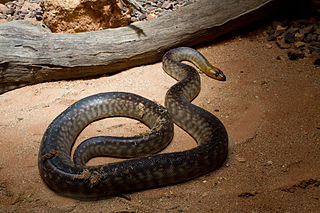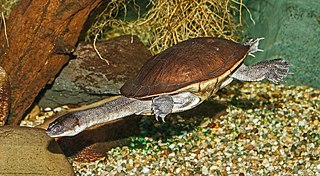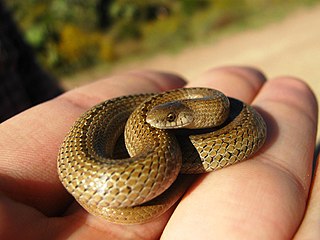
Garter snake is the common name for inoffensive, harmless, small to medium-sized snakes belonging to the genus Thamnophis in the family Colubridae. Native to North and Central America, species in the genus Thamnophis can be found in all of the lower 48 United States, and nearly all of the Canadian provinces south of the Northwest Territories and Nunavut—with the exception of Prince Edward Island and Newfoundland and Labrador. They are found from the subarctic plains of west-central Canada east through Ontario and Quebec; from the Maritime Provinces and south to Florida, across the southern and central U.S. into the arid regions of the southwest and México, Guatemala and south to the neotropics and Costa Rica.

The Acrochordidae, commonly known as wart snakes, Java wart snakes, file snakes, elephant trunk snakes, or dogface snakes are a monogeneric family created for the genus Acrochordus. This is a group of basal aquatic snakes found in Australia and tropical Asia. Currently, three species are recognized.

Morelia is a genus of large snakes in the family Pythonidae found in Indonesia, New Guinea, and throughout Australia. Currently, up to eight species are recognized.

Drymarchon is a genus of large nonvenomous colubrid snakes, commonly known as indigo snakes or cribos, found in the Southeastern United States, Central America, and South America.

The woma python, also known commonly as Ramsay's python, the sand python, and simply the woma, is a species of snake in the family Pythonidae, endemic to Australia. Once common throughout Western Australia, it has become critically endangered in some regions.

The eastern hog-nosed snake, also known as the spreading adder and by various other common names, is a species of mildly venomous rear-fanged snake in the family Colubridae. The species is endemic to North America. There are no subspecies that are recognized as being valid.

Python is a genus of constricting snakes in the Pythonidae family native to the tropics and subtropics of the Eastern Hemisphere.

Leptotyphlops is a genus of nonvenomous blind snakes, commonly known as slender blind snakes and threadsnakes, in the family Leptotyphlopidae. The genus is endemic to and found throughout Africa. Eleven species have been moved to the genus Trilepida, and other species have been moved to the genera Epacrophis, Epictia, Mitophis, Myriopholis, Namibiana, Rena, Siagonodon, Tetracheilostoma, and Tricheilostoma.

The Colubrinae are a subfamily of the family Colubridae of snakes. It includes numerous genera, and although taxonomic sources often disagree on the exact number, The Reptile Database lists 717 species in 92 genera as of September 2019. It is the second largest subfamily of colubrids, after Dipsadinae. Many of the most commonly known snakes are members of this subfamily, including rat snakes, king snakes, milk snakes, vine snakes, and indigo snakes.

The Roti Island snake-necked turtle, also commonly known as McCord's snakeneck turtle, is a critically endangered turtle species. It is named after Rote Island in Indonesia where it was first discovered. Some individuals were later discovered in East Timor, and are considered a distinct subspecies.

Daboia palaestinae, also known as the Palestine viper, is a viper species endemic to the Levant. Like all vipers, it is venomous. It is considered a leading cause of snakebite within its range. No subspecies are currently recognized.

Hydrophis is a genus of sea snakes, venomous snakes in the subfamily Hydrophiinae of the family Elapidae. Species in the genus Hydrophis are typically found in Indo-Australian and Southeast Asian waters. Currently, around 36 species are recognized as being valid.
Pritchard's snake-necked turtle is a species of turtles in the family Chelidae. The species is endemic to a restricted area of Central Province, Papua New Guinea.

Crotalus stejnegeri, commonly known as the Sinaloan long-tailed rattlesnake or just long-tailed rattlesnake, is a venomous pit viper species in the family Viperidae. The species is native to western Mexico. There are no recognized subspecies.
Conopsis is a genus of snakes in the family Colubridae. The genus is endemic to Mexico.
Conopsis acuta, the spotted Tolucan earth snake, is a species of nonvenomous snake in the family Colubridae. The species is found in Mexico.

Conopsis lineata, the lined Tolucan ground snake or lined Tolucan earth snake, is a species of nonvenomous snake in the family Colubridae. The species is found in Mexico.

Conopsis megalodon, the San Felipe ground snake, is a species of nonvenomous snake in the family Colubridae. The species is found in Mexico.

Conopsis nasus, the largenose earth snake, is a species of nonvenomous snake in the family Colubridae. The species is found in Mexico.

















